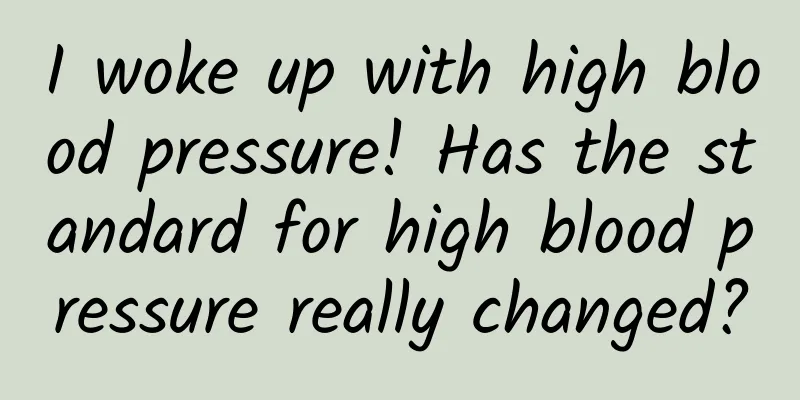I woke up with high blood pressure! Has the standard for high blood pressure really changed?

|
Recently, there have been news that the diagnostic threshold for hypertension in adults in my country has been lowered from ≥140/90mmHg to ≥130/80mmHg. After hearing this news, many people said: I woke up and found out I have hypertension! Don't panic yet. In fact, there are still disputes over the revision of the diagnostic criteria for hypertension. The National Health Commission also issued a response stating that the diagnostic criteria for hypertension have not been adjusted at present. This issue of NetEase Health's "Health Concerns" has sorted out relevant information for you. Let's take a look! Have the diagnostic criteria for hypertension changed? The National Health Commission responded: No adjustments have been made at present On November 13, the "Chinese Hypertension Clinical Practice Guidelines" jointly formulated and issued by the National Center for Cardiovascular Diseases, the Chinese Medical Association, the Chinese Medical Association Hypertension Professional Committee, the Chinese Medical Association Cardiovascular Disease Branch, and the Cross-Strait Medical and Health Exchange Association Hypertension Professional Committee were issued, recommending that the diagnostic threshold for hypertension in Chinese adults be lowered to 130/80 mmHg. For a time, netizens were discussing this, and medical experts also held different opinions. On November 15, the National Health Commission issued an authoritative answer: The state has standardized procedures for the formulation of diagnostic standards for diseases such as hypertension. Guidelines and consensus issued by professional institutions, industry associations, and individuals are the research results of experts and are not used as national disease diagnostic standards. Regarding the diagnostic criteria for hypertension, the publicity and education points, prevention and treatment guidelines, and clinical pathways issued by the national health administrative departments in 2005, 2010, and 2017 all clearly stated that the diagnostic criteria for adult hypertension is blood pressure exceeding 140/90 mmHg three times on different days. At present, the country has not adjusted the diagnostic criteria for adult hypertension. What are the differences between the two versions of the guidelines? Experts express different opinions Before the release of the "Chinese Hypertension Clinical Practice Guidelines", China's hypertension diagnostic criteria used the "Chinese Hypertension Prevention and Treatment Guidelines (2018 Revised Edition)". NetEase Health has compared the two versions of the guidelines for you: (Click the image below to view detailed information↓) Regarding the formulation of the "new guidelines", Han Yaling, chairman of the Chinese Medical Association's Cardiovascular Disease Branch and academician of the Chinese Academy of Engineering, said at the press conference that although the reduction of the diagnostic value of hypertension has increased the number of people included in the hypertension range, the cost of early treatment may increase slightly, but the high cost of subsequent treatment of serious complications such as stroke, myocardial infarction, renal insufficiency, etc. will be greatly reduced, and the quality of life of patients will be significantly improved and their life span will be extended. According to the new standard, the number of hypertensive patients in China will increase from 245 million to nearly 500 million, and more than one-third of the Chinese people will become hypertensive patients. Professor Liu Lisheng, Honorary Chairman of the China Hypertension Alliance, told the Medical World that the hypertension range in the drug treatment guidelines for hypertension published by WHO in 2021 is still 140/90 mmHg. She pointed out that according to the new guidelines, the number of hypertensive patients in China will double, which will not only cause concerns among patients, but also whether the country's health economy can support so many hypertensive patients is also a question. Zhang Haicheng, chief physician of the Department of Cardiology at Peking University People's Hospital, told NetEase Health that the new guidelines are inconsistent with the Chinese hypertension prevention and treatment guidelines that have been followed in clinical practice in my country, which is likely to cause confusion. In addition, whether the previous home self-measured blood pressure of 135/85mmHg suddenly changed to 130/80mmHg is sufficient, and the sudden change in the diagnostic criteria of ABPM (ambulatory blood pressure monitoring) also requires evidence-based research. Given that hypertension is a common risk factor for cardiovascular and cerebrovascular diseases (and ranks first), it is a social issue with wide-ranging implications and far-reaching impacts. The reduction of its diagnostic standards involves a series of problems faced by hundreds of millions of people who suddenly become hypertensive patients from a healthy state, such as entry requirements for special jobs, retirement due to illness, commercial insurance, and academically, for example, the CHA2DS2-VASc score of patients with atrial fibrillation suddenly increases by one point, which will inevitably increase the number of people who need anticoagulation, and the HASBLED score of bleeding risk will also increase by one point accordingly. There are also health economics of national medical expenditures and benefits, and the sense of shame of suddenly changing from a healthy person to a patient. Therefore, the revision of the diagnostic criteria for hypertension must be reasonable (feasible), appropriate (accessible) and in line with my country's national conditions (sustainable). My suggestion is that if the diagnostic criteria for hypertension are to be adjusted, the National Health Commission, the National Development and Reform Commission, the Medical Insurance Bureau, the Food and Drug Administration, the Ministry of Human Resources and Social Security and other relevant units should fully discuss and widely solicit opinions before issuing a trial version. This is not the first time that the standard for high blood pressure has changed In fact, the standard for high blood pressure has undergone many adjustments over the past 40 years: In 1977, the World Health Organization proposed the diagnostic standard for hypertension as 160/95 mmHg; In 1984, medical scientists first proposed the concept of "high normal blood pressure"; In 1993, blood pressure below 130/85 mmHg was further defined as normal blood pressure; In 1999, the World Health Organization/International Society of Hypertension treatment guidelines set the diagnostic standard for hypertension at 140/90 mmHg. The new diagnostic standard of 130/80 mmHg was first proposed in the "2017 American College of Cardiology/American Heart Association Hypertension Guidelines", which also sparked widespread discussion and controversy at the time. The latest European guidelines for the treatment of hypertension in children and adolescents released in 2022 have also defined hypertension as 130/80 mmHg. In addition, the 2022 Hypertension Guidelines issued by Taiwan, China also adopted similar standards, recommending 130/80 mmHg as the blood pressure control target value for most hypertensive patients. Don’t be afraid! What should you do if your blood pressure is hovering around the standard line? Many people are a little panicked about the reality of being "diagnosed with high blood pressure" overnight. Do they have to take antihypertensive drugs every day from now on? In fact, patients with systolic blood pressure of 130-139 mmHg and/or diastolic blood pressure of 80-89 mmHg and without clinical comorbidities, target organ damage or ≥3 cardiovascular risk factors (such as smoking, dysglycemia, dyslipidemia, obesity, etc.) are classified as non-high-risk patients in the cardiovascular risk stratification in the "New Guidelines" and can undergo 3-6 months of lifestyle intervention. If the systolic blood pressure is still ≥130 mmHg and/or the diastolic blood pressure is still ≥80 mmHg, antihypertensive drug treatment can be considered. At the same time, it is also very important to learn to monitor blood pressure scientifically. Choosing a blood pressure monitor: When measuring blood pressure at home, it is best to choose an upper arm electronic blood pressure monitor produced by a regular manufacturer. Choose your arm: When measuring your blood pressure for the first time, measure both arms and use the side with the higher blood pressure as the basis. Choose a posture: You should sit when measuring your blood pressure. If the situation does not allow, you can lie down for measurement. Lie on your back and do not lie on your side. Remember to keep the cuff at the same height as your heart. Choose a time: measure blood pressure once in the morning and once in the evening every day; in the morning: measure before taking medicine, before breakfast, and after urination; in the evening: measure before dinner. If you miss it, measure within 1 hour before going to bed. If you take medicine at night, it is recommended to measure before taking medicine. Finally, in addition to taking medication, controlling blood pressure also requires lifestyle intervention. If you are already hovering around the "high blood pressure line", you can choose to replace ordinary table salt with low-sodium salt in your diet. Exercise is also an effective way to lower blood pressure. You can increase various physical activities within your ability as much as possible according to your own situation. Common aerobic exercises such as brisk walking, jogging, swimming, cycling, aerobics, skipping rope, etc. are all very suitable. Perhaps, it will take some time and some controversy to adjust the hypertension standards, but maintaining a healthy lifestyle and paying attention to disease prevention are eternal issues for each of us. |
>>: How much money can popular apps make? – Data Infographic
Recommend
Why is the chest-knee position not recommended?
The knee-chest position is a method used to adjus...
Is the bloating in the lower abdomen due to pregnancy?
Lower abdominal bloating may be caused by eating ...
What causes Trichomonas fungus
Trichomonas fungus is a fungal infection that occ...
What causes blood clots during menstruation in women?
For women, they basically feel a little annoyed w...
Causes of yellow leucorrhea during pregnancy
We all know that leucorrhea is a "barometer&...
6 Misconceptions about Eating Whole Grains! The first one you may be doing
Every time I ask what I need to bring back home, ...
A physical examination revealed elevated "tumor markers". How far is it from cancer?
During the physical examination, I believe many f...
This kind of "black sesame" cannot be eaten, be careful of Datura poisoning!
Datura is an annual herbaceous plant of the Solan...
What are the breast enhancement methods of traditional Chinese medicine?
What are the traditional Chinese medicine methods...
Is it normal for the car oil dipstick to smell like gasoline? Why does the oil dipstick smell like gasoline?
The car oil dipstick is a measuring tool used to ...
Are vaginal warts easy to treat?
As we all know, there are many reproductive organ...
Your walking posture may have been wrong all along! It's ugly and hurts your legs! The correct way is...
Your walking posture may have been wrong all alon...
What causes pain in the lower left side of a woman's abdomen?
Most women have experienced abdominal pain to a g...









